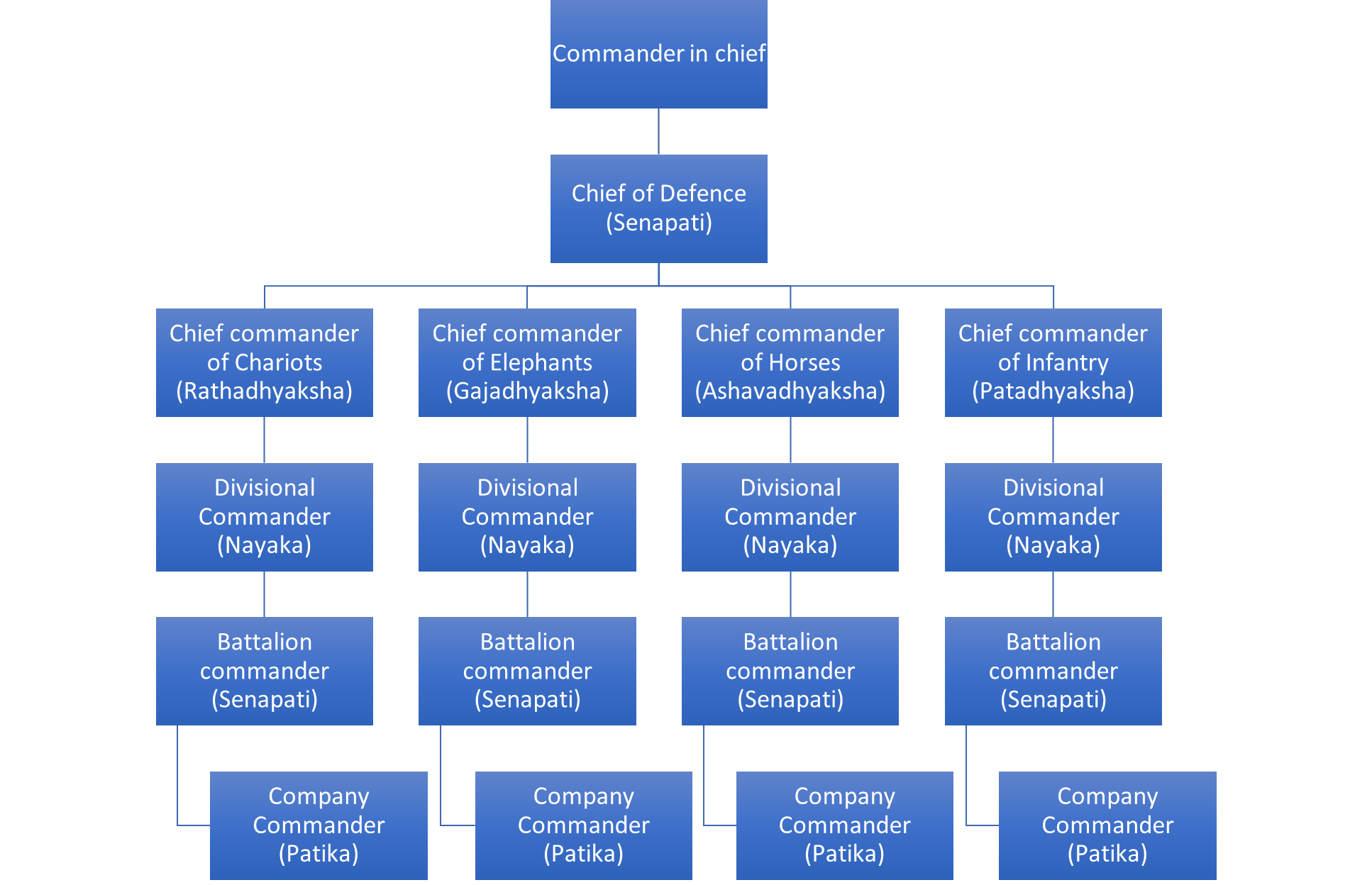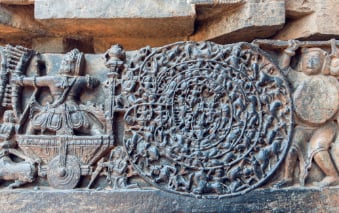Warfare in Ancient Bharat: Part 2 of 2
Published by
Sri Sivani Charan Yalamanchi
on
This is the second of the 2-part essay that delves into the warfare rules of engagement, ethics, and overall perspectives in ancient Bharat. The essay is part of the academic requirement for the HUA course ‘Reconstructing Hindu History – The Omissions’ taught by Dr. Raj Vedam. The first part briefly introduced different works on warfare, when war is justified, different types of war, and ethics and rules of war.
This essay will cover the army composition, its organizational structure, troops distribution, war strategy, and weaponry.
.jpg?width=969&height=609&name=shutterstock_695821066%20(1).jpg)
Warfare in Ancient Bharat: Part 2 of 2
Army Composition
The army was considered one of the seven key elements of a state. According to Sukra Niti, what a mind is to man, an army is to a state. So, without an army, a state comes to a standstill. It also states, “There is neither kingdom, nor wealth, nor prowess. The treasury is the root of the army, and the army is the root of the treasury. It is by maintaining the army that the treasury and the kingdom prosper, and the enemy is destroyed.”
The ancient Hindu armies had a four-fold division called ‘caturanga-bala’ consisting of chariots, elephants, cavalry, and infantry in this order of prominence.
Chariots:
They were considered the most important in warfare. Sukra had mentioned of the iron chariot which consisted of swift-moving wheels, with good seats for the warriors and a seat in the middle for the charioteer and it was equipped with different offensive and defensive weapons. The Mahabharata had an elaborate mention of chariots.
Elephants:
Elephants are considered the next important force in the army. Greek ambassador Megasthenes explains how the elephants were hunted and tamed in Bharat. Some of the prominent works that deal with elephants are the Hastyayurveda of Palapakya and the Matangalila of Narayana. Roman historian Curtius Rufus mentions that the elephants created great terror and their trumpets frightened the Greek horses and their riders. They caused much disorder in the ranks, and veterans of many victories looked for shelter.
He also says that the most dismal sight was elephants gripping the Greek soldiers with their trunks, hoisting them above their heads, and delivering them to their soldiers to be beheaded. Similarly, Diodorus and Plutarch mentioned elephant warfare and their strength in the war between Alexander and Purushottam (Porus). According to Dhanurveda, the military training of elephants consists of mountaineering, moving through the water, running, jumping, rising, sitting, etc. The elephants should be made devoid of fear by putting them inside fire circles.
Cavalry:
The cavalrymen rode the horses with a whip that was fixed to the wrist unlike for the horses of a chariot. The cavalrymen were armed with bows and arrows or a spear or a sword. The cavalry had a wide range of tactical advantages. It was indispensable in situations requiring quickness of movement. Eminent works that deal with Horses and cavalry are Asva Sastra of Hemasuri and Asvacikitsa of Nakula.
Infantry:
According to the Agni Purana, victory attends to those armies where foot soldiers i.e., the infantry are numerically strong. The Sukraniti mentions foot soldiers possess firearms during combat. Dhanurveda mentions that the soldiers in an infantry should be of equal height and everyone in the infantry should be an expert in jumping and running. Moreover, they should be trained to move backward, stand still, run, and run apace rushing headlong into the hostile army, and move in different directions according to signals. According to Arrian, “They carry a bow made of equal length with the man who bears it.
This they rest upon the ground and pressing against it with their left foot, thus discharge the arrow having drawn the string backward: the shaft they use is little short of being three yards long, and there is nothing which can resist an Indian archer's shot - neither shield nor breastplate nor any stronger defense if such there be”. Arrian also says, “All Indians are free. The Indian army was in constant pay, during war and peace. Arms and horses supplied by the state and army never ravaged the country. The bravery of the army is superior to any other army they had to contend with.”
Besides the four-fold classification of the army, Artha Sastra mentions a six-fold division. According to this division, the army consisted of six ‘limbs’ which are:
-
Maula (hereditary troops)
-
Bhrita (territorial army)
-
Sreni (organized militias)
-
Mitra (friendly troops)
-
Amrita (alien forces)
-
Atavi (jungle tribal forces)
Army Organizational Structure
According to Artha Sastra, Army's organizational structure is as follows:

-
Patika – Commander of ten units of the army.
-
Senapati – Commander of 10 Patikas.
-
Nayaka – Commander of 10 Senapatis.
Troop Distribution
Scriptures, such as The Mahabharata, mention the distribution of troops into nine different units namely: Patti, Senamukha, Gulma, Gana, Vahini, Pruthana, Chamu, Anikini, Akshauhini. Each unit consists of chariots, elephants, horses, and foot soldiers in the ratio of 1:1:3:5. The following table explains the composition of each unit taken from The Mahabharata, Aadi Parva (Adhyayam 2, verses 19-26).
|
Unit
|
Chariot
|
Elephant
|
Horse
|
Foot
|
|
Patti
|
1
|
1
|
3
|
5
|
|
Senamukha
|
3
|
3
|
9
|
15
|
|
Gulma
|
9
|
9
|
27
|
45
|
|
Gana
|
27
|
27
|
81
|
135
|
|
Vahini
|
81
|
81
|
243
|
405
|
|
Pruthana
|
243
|
243
|
729
|
1,215
|
|
Chamu
|
729
|
729
|
2,187
|
3,645
|
|
Anikini
|
2,187
|
2,187
|
6,561
|
10,935
|
|
Akshauhini
|
21,870
|
21,870
|
65,610
|
1,09,350
|
War strategy
There are several different types of military formations mentioned in Hindu scriptures. Some of these formations are: Padma Vyuha, Chakra Vyuha, Ratha Vyuha, Sarpa Vyuha, Garuda Vyuha, Simha Vyuha, Agni Vyuha, Danda Vyuha, Matsya Vyuha, Makara Vyuha, Sucimukha Vyuha, Sakata Vyuha, Vajra Vyuha etc. The type of vyuha (array) used shall depend on the type of anticipated attack.
|
Anticipated attack
|
Array used
|
|
In the front
|
Makara (Crocodile), Pipilika (Ant)
|
|
In the rear
|
Sakata (Carriage)
|
|
On the two flanks
|
Vajra (Thunderbolt)
|
|
On all sides
|
Sarvato badra (Uniformly circular), Danda (Staff)
|
|
If the path is narrow
|
Suchi (Needle)
|
|
Both sides from left and right
|
Varaha (Boar) or Garuda (Bird)
|
Weaponry
According to Dhanurveda, weapons fall into four categories based on their nature:
-
Mukta – which are thrown
-
Amukta – which are not thrown
-
Muktamukta – which are thrown or not thrown
-
Yantramukta – which are thrown by spells
Twelve weapons fall under the Mukta category: Dhanu (Bow), Arrow, Bindivala (Crooked club), Sakti (Spear), Drughana (Hatchet), Tomara (Tomahawk), Nalika (Musket), Laguda (Club), Pasa (Lasso), Cakra (Discus), Danta kantaka (Tooth-thorn), Musundi (Octagon-headed club)
The Amukta class consists of the following twenty weapons: Vajra (Thunderbolt), Hand sword, Parasu (Axe), Gosirsa (Cow-horn spear), Asidheny (Stiletto), Lavitra (Scythe), Astara (Bumarang), Kunta (Lance), Sthuna (Anvil), Prasa (Spear), Pinaka or Trisula (Trident), Gada (Club), Mudgara (Hammer), Sira (Ploughshare), Musala (Pestle), Pattisa (Battle-axe), Maustika (Fist-sword, Dagger), Parigha (Battering-ram), Mayukhi (Pole), Satagni (Hundred-killer)
The Muktamukta class weapons were further classified into two classes, namely Sopasamhara (connected with the withdrawing or restraining Upasamhara) and the Upasamhara themselves which are the restrainers of the previous class. There are forty-four varieties in the Sopasamhara class and fifty-four varieties in Upasamhara class.
There are only six weapons in the Yantramukta class, and nothing can defeat these six weapons.
- Visnuchakra (Discus of Vishnu)
- Vajrastra (Thunderbolt)
- Brahmastra (Brahma’s Missile)
- Kalapasaka (Noose of death)
- Narayanastra (Missile of Narayana)
- Pasupatastra (Missile of Pasupati)
Unlike Dhanurveda, the Agnipurana classified weapons into five categories. 1. Yantramukta, those thrown by a machine, 2. Panimukta, those thrown by the hand, 3. Mukta-sandharita, those thrown and drawn back, 4. Amukta, those which ate not thrown, and 5. Bahuyuddha, weapons that the body provides for personal struggle. Gustav Oppert in his monologue, ‘On the weapons, army organization and political maxims of the ancient Hindus’, mentions that there are other classifications besides the previously mentioned.
Likewise, various treatises consist of different opinions regarding the superiority of one weapon over the other. For example, Vaisampayana in his Niti Prakasika had high regard for the sword whereas according to Agnipurana, it was considered a subaltern weapon where battles fought with bows are considered noble followed by fighting with spears, swords, and wrestling is considered the worst form of fighting. He also says that the efficiency of the weapons varies and is subject to great changes. Because of the construction mode, the materials used to make a weapon are different, and the quality of a weapon is not the same in different ages and places.
Besides, increasing, decreasing, and preserving the efficiency of a weapon depends a lot on the strength and ability of a person who uses such arms. One notable mention is that according to Gustav, gunpowder can be attributed to Niti Prakasika and Sukraniti. He also mentions that the gunpowder equivalent in Sanskrit is ‘agnicurna’ also called ‘curna’.
Conclusion
Hindu civilization had a rich knowledge of warfare, weapons, military strategies, and martial arts. This made the Hindu kings resist armed Islamic and Portuguese invasions in its history for the longest time which was nowhere to be seen across other civilizations in the world. Despite the mention of gunpowder in Hindu scriptures, and the training of elephants with fire circles to make them devoid of fear, we don’t witness any usage of fire weapons in Bharat’s armed struggle concerning Islamic invasions.
Moreover, Muslim historians recorded instances where naphtha balls were thrown against the rushing elephants and frighten them in wars between Rajputs and Turkish invaders from the North-West (Elliot and Dowson, vol. I). In any case, this rich knowledge combined with our ancestors rooted in Dharmic values led to the failure of total Islamization and the Christianization of Bharat.
References and Works Consulted
Chakravarti, P.C., The Art of War in Ancient India (General Printers & Publishers, 1941), University of Dacca. Accessed at https://archive.org/details/in.ernet.dli.2015.282006
Hema Hari, D.K. and Hari, D.K., Autobiography of India: Breaking the Myths – About Identity (Sri Sri Publications Trust, 2018), accessed at https://www.amazon.com/Autobiography-India-Identity-Breaking-Myths-Vol1-About-ebook/dp/B07C15GJMG
John C. Rolfe, Litt. D., Curtius Rufus, Quintus [History of Alexander], (Harvard University Press, 1946), University of Pennsylvania. Accessed at https://archive.org/details/quintuscurtius0002unse/page/n7/mode/2up
McCrindle J.W., Ancient India as described by Megasthenes and Arrian, (Thacker, Spink & Co., 1877). Accessed at https://archive.org/details/ancientindiaasd01mccrgoog/page/n6/mode/2up
Mookerji, Radha Kumud, Chandragupta Maurya and His Times, University of Madras, 1943. Accessed at https://archive.org/details/in.ernet.dli.2015.281321.
Oppert Gustav, NitiPrakasika, (Higginbotham And Co, 1882). Accessed at https://archive.org/details/in.ernet.dli.2015.217444
Oppert Gustav, On the weapons, army organization, and political maxims of the Ancient Hindus, (New Order Book Co, 1967). Accessed at https://archive.org/details/in.gov.ignca.46936
Rangarajan, L.N., Kautilya, The Arthashastra (Penguin Books, 1992). Accessed at https://archive.org/details/kautaliya-arthshashtra-ancient-India/mode/2up
Ramachandra Dikshitar, V.R., War in Ancient India (Macmillan & Co., 1944), University of Madras. Accessed at https://archive.org/details/in.ernet.dli.2015.503472
Ray, Purnima, Vasişţa’s Dhanurveda Samhitā (J.P. Publishing House, 2003). Accessed at https://archive.org/details/in.ernet.dli.2015.382701
Thippabhatla RamaKrishnaMurthy, Suram Srinivasulu., Shrimahabharatam aadiparvamu-sabhaparvamu-part-1 (Gita Press, Gorakhpur, 2018) Accessed at https://www.gitapress.org/bookdetail/shrimahabharatamu-aadiparvamu-sabhaparvamu-part-1-telugu-2141
Vittal, Vinay, “Kautilya’s Arthasastra: A timeless Grand strategy” (Graduate Thesis, Maxwell Air Force Base, AL. 2011). Accessed at https://apps.dtic.mil/sti/pdfs/AD1019423.pdf
Ancient Indian Warfare, accessed at https://www.worldhistory.org/Indian_Warfare/
Dhanurveda - Works on ancient Indian artilleries. Accessed at http://mahabharata-research.com/onewebmedia/chapter%203.pdf
Hindu Online, accessed at http://hinduonline.co/scriptures/dhanurveda/dhanurveda.html
Mahabharatam, in Telugu (Gita Press, Gorakhpur, 2016). First edition.
Surya’s Tapestry, accessed at https://www.hinduwisdom.info/War_in_Ancient_India.htm
We acknowledge the editorial assistance provided by Dr. Kalyani Samantray, Sri Sri University, Odisha, India.
Tags:
Hindu Studies,
Studying religion,
Hindu Philosophy,
Ramayana,
Peace and Conflict Studies,
Dhanurveda,
Veda,
History,
Historiography,
Sanatana Dharma,
Warfare,
Society,
Arthashastra,
Manu Smriti,
Mahabharata,
History and Methods



